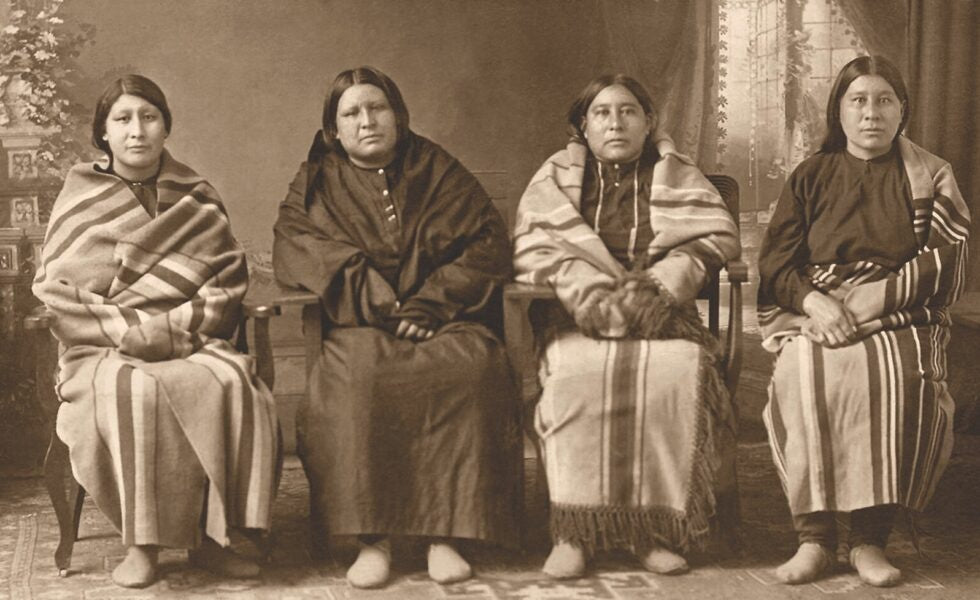
Pendleton blankets are renowned across the USA and internationally for their exceptional quality and unique, vibrant designs. Every woolen blanket tells a unique story and, cared for correctly, will endure for generations to come.
These blankets are synonymous with Native Americans, and they originated as American Indian Trade Blankets designed and created specifically for Native tribes in the USA’s West and Midwest.
Before Wool…
Before Europeans were first recorded to have landed on the North American continent in the 1490s, Native Americans made blankets of animal hides or pelts. Depending on the location and availability of resources, these included everything from bison and bear skins to those of beavers and other small mammals, which necessitated being sewn together. They also used materials including feathers, bark, reeds, or down to weave blankets.
Upon the European arrival to American Indian lands, bartering for goods was important for the visitors and settlers, and European woven wool blankets were highly sought after by the native people; the more vibrant, the better. Woolen blankets soon became very valuable trading items that benefited both parties.
What are “Trade Blankets”?
The first blankets to be widely traded for other goods with the Native Americans were brought from Europe and featured the block and plaid designs preferred there. By the end of the 1800s, however, the Pendleton Woolen Mills in Oregon saw a distinct market for creating blankets specifically for trading purposes and featuring tribal designs.
The first of these trade blankets were designed in 1909 for the Northwest’s Umatilla, Walla Walla, and Cayuse tribes. Instantly popular, word soon spread, and they became highly coveted by other tribes further afield, as well as by white tourists to the region seeking to purchase these as souvenirs.
With many diverse tribal groups across the USA and more than 300,000 individual Native Americans at the turn of the last century, Pendleton sought to capture the market as effectively as possible. This required understanding the traditions, legends, and preferences of their Native customers.
Pendleton learned that each tribal group had its own unique stories, designs, and color preferences, and the goal was to create blankets that reflected these for each group. For example, the color schemes and designs favored by the Crow were unpopular with the Navajo – so a different approach was essential.
To ensure authenticity, Pendleton dispatched representatives to visit various tribes to understand their needs and preferences. Trade blankets were shortly thereafter expanded from the tribes of the North to those in the Southwest – Navajo, Hopi, and Zuni.
How Were Trade Blankets Used?
Thanks to the technologies of the time, the traditional native patterns could be expressed in sharper, more vivid detail and much more vibrantly than was possible with traditional weaving practices. Large volumes of these blankets were sent to the relevant tribes across the USA and traded for items of value – in the Southwest, these included wool, silver jewelry, pottery, and more.
For the Native Americans, as well as being useful, the blankets were seen as an investment. Economically, to prepare for future potential hardship, a good quality blanket was acquired by women (men tended to seek a good watch) as an item that could be pawned for a significant sum if necessary in the future.
Pendleton trade blankets were not only a standard of value for credit and trading but also a popular form of apparel that was used ceremonially as well as for everyday wear. They were used for pow-wows, dowries, weddings, baby naming ceremonies, memorials and funerals, to line coffins, and for general gifting.
Pendleton “Trade” Blankets Today
According to Navajo anthropologist Rain Parrish, today these blankets continue to be highly prized within native communities. Traditionally, for example, the Navajo welcome a new baby with a crib blanket, and a couple’s marriage is blessed by draping the bride’s body with a Pendleton blanket. The groom is often draped with a Pendelton robe.
At Indian Traders, we have a vast array of these stunning Native American blankets – from king-size to throws, crib, and saddle blankets. Our range includes Chief Joseph blankets, National Park blankets, and many other collections. We also have several American Indian College Fund products – for which a percentage of proceeds directly supports thousands of Native American students to receive an education in one of more than thirty tribal colleges across the USA.
See for yourself today – and shop with us for a beautiful investment piece you will use and treasure.
